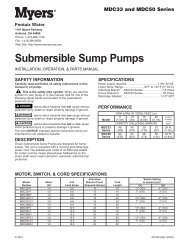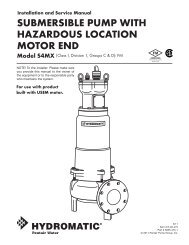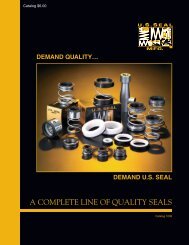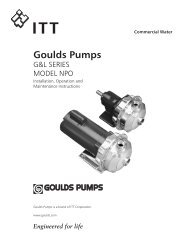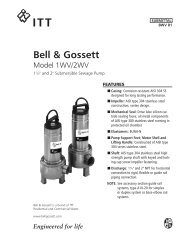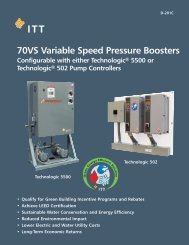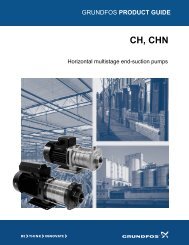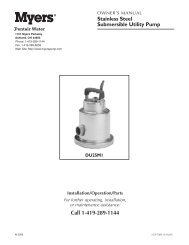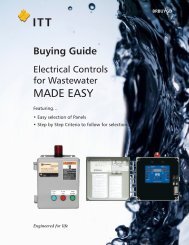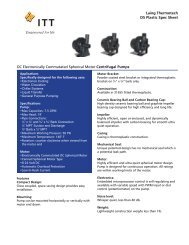Submersible Sewage Ejector Pump - Sump Pumps
Submersible Sewage Ejector Pump - Sump Pumps
Submersible Sewage Ejector Pump - Sump Pumps
You also want an ePaper? Increase the reach of your titles
YUMPU automatically turns print PDFs into web optimized ePapers that Google loves.
pounds of air pressure. Air<br />
bubbles should appear at first,<br />
then stop. If air bubbles<br />
continue, then recheck seals.<br />
20.Fill the motor cap with<br />
high-grade transformer oil<br />
such as Sohio (6) Factopure<br />
SE40 Oil (or equivalent) to<br />
at least 1⁄4" over motor<br />
windings top plate, or to the<br />
top of the stator.<br />
Do not fill the motor housing<br />
completely. Allow air space<br />
for expansion.<br />
Replace oil pipe plug (14).<br />
Recheck with ohmmeter<br />
before applying power.<br />
21.Plug the power cord into a<br />
grounded outlet and check<br />
pump running. Motor should<br />
run smoothly and be free<br />
of vibration.<br />
2. Water level in sump may be<br />
too low to activate automatic<br />
switch. See installation for<br />
proper on/off levels.<br />
3. <strong>Pump</strong> and/or switch cord plug<br />
may not be making contact<br />
in receptacle.<br />
4. If pump is using the series<br />
(piggyback) cord plug, the two<br />
plugs may not be plugged<br />
together tightly.<br />
5. Float may be stuck. Be sure<br />
float operates freely in basin.<br />
6. If the unit is being operated by<br />
the optional float control<br />
switch, unplug the pump from<br />
the piggyback receptacle and<br />
plug the pump directly into<br />
the power source. If the<br />
pump starts each time it is<br />
plugged directly into the<br />
receptacle and does not start<br />
each time when plugged into<br />
the piggyback switch with<br />
the float raised up to a start<br />
position, replace the complete<br />
piggyback switch assembly<br />
and retest with new assembly.<br />
7. If all symptoms check OK,<br />
motor winding may be open;<br />
take to authorized service<br />
center for check.<br />
<strong>Pump</strong> runs but does not<br />
deliver water.<br />
1. Check valve may be installed<br />
backward. Arrow on valve<br />
points in direction of flow.<br />
2. Discharge shutoff valve, if<br />
used, may be closed.<br />
3. <strong>Pump</strong> may be air locked. Start<br />
and stop several times by<br />
plugging and unplugging cord.<br />
<strong>Pump</strong><br />
Troubleshooting<br />
1 14<br />
3 2<br />
Servicing should be performed<br />
only by an authorized Hydromatic<br />
service center.<br />
Warning: Always disconnect the<br />
pump from power source<br />
before handling or making any<br />
adjustments. Always wear<br />
rubber boots when there is<br />
water on the floor and you must<br />
unplug the pump or make<br />
any adjustments.<br />
7<br />
15<br />
19<br />
20<br />
18<br />
17<br />
4<br />
12<br />
21<br />
8<br />
Note: Automatic thermal<br />
overload protects the sealed-inoil<br />
motor. Running dry may<br />
overheat the motor and activate<br />
the overload protector until the<br />
unit cools.<br />
6<br />
9<br />
<strong>Pump</strong> does not run or just hums.<br />
1. Line circuit breaker may be off,<br />
or fuse may be blown or loose.<br />
11<br />
10<br />
5



